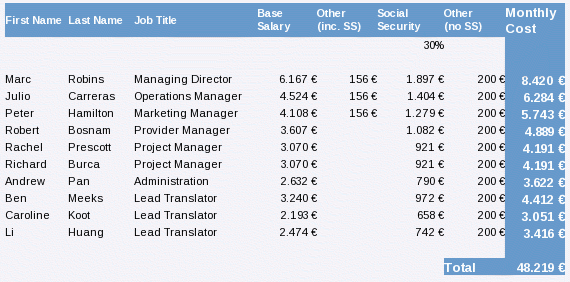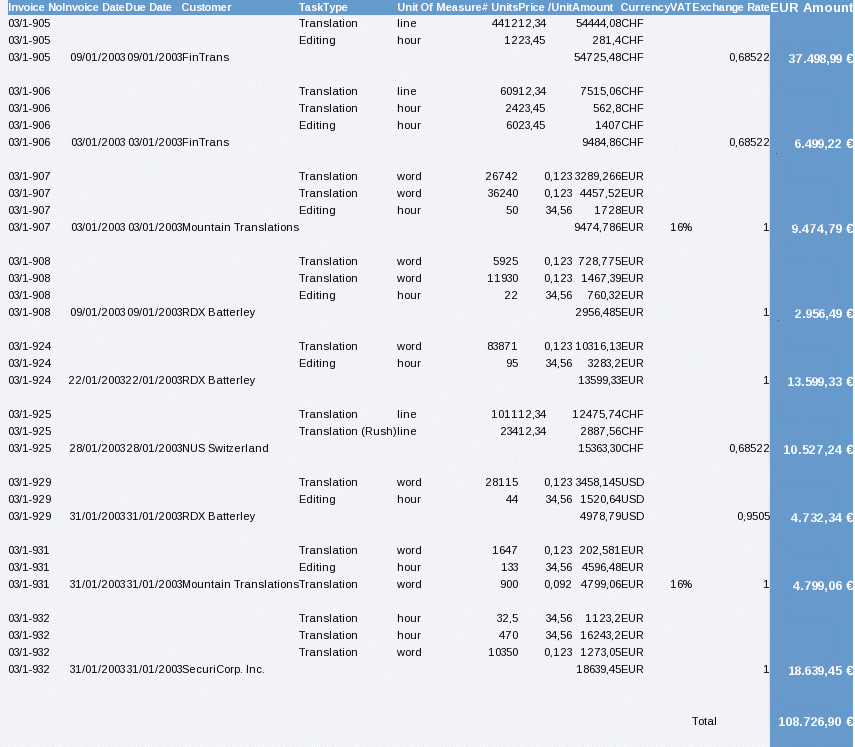FI Financial Controlling Sample Case
How do I manage the finance and controlling of a small-medium service company? The following tutorial explains you the basics of the finance module of the ]project-open[ open-source software.
It uses the example of a small translation agency that manages its finance using a number of MS-Excel sheets. These Excel sheets represent the financial model of ]po[ application, just without a database.
Please don't worry if your company is from a different sector. Project and services oriented organizations tend to be very similar financially, so you probably can use the same model without changes. Most of the sample material below has actually been taken from a strategic consulting company and an IT consultancy...
The Case: Tigerpond S.L.
"Tigerpond Translations S.L." is a privately held "limited company" (American: Inc., Spanish, French, Italian: S.L., German: GmbH, etc.). Tigerpond has some 10 full-time employees and customers and provider in several countries.
In the following sections we are going through a number of Excel tables (here as HTML tables), each dealing with a specific aspect of the company. These tables are similar in structure to the packages of the ]po[ finance module.
Invoices
The table below shows a fictitious list of invoices for January 2003. Each invoice consists of a number of "invoice lines" together with fields for "TaskType" (for data warehouse analysis), "Unit", "Price/Unit" and "Currency". The Invoice Items are summed up to form the final invoice amount.
In order to deal with multiple invoice currencies we included a column with the exchange rate (at the time of invoicing ), so we can calculate the estimated EUR amount of the invoice. There will always be a difference between invoice amount and the cash received in your account because of currency rate differences. That's ok for controlling and "analytical accounting", you just have to accept it and you have to separate clearly between invoices and payments. For "invoicing" this difference is not OK, and you tax consultant will insist in assigning the difference between invoiced and paid amount in a separate account.
- The table below doesn't contain a VAT (value added tax) column. VAT is added to the invoice amount if you are selling within your own country. In our example below, only "Mountain Translations" is located in the same country, so we have to charge them 16% more. However, we will have to return this money either by paying VAT to our providers or at the end of the year.
Payroll and Human Resources Costs
The larges single cost element in all project-related organizations is "human capital".
- The payroll information below includes a column for social security which only applies in Europe as far as I know
- "Other" costs include optional packages such as a health or retirement plant, company car etc. Some of these items need to be included in the social security, but other don't. So we have got one column "Other (inc. SS)" that add to SS, and a second column "Other (no SS)" that doesn't. Examples are a company car for the senior managers (156â¬/month) and a supplementary retirement plant (200â¬/month).

Download the original MS-Excel sheet here.
Contact Us
Project Open Business Solutions S.L.
Calle Aprestadora 19, 12o-2a
08902 Hospitalet de Llobregat (Barcelona)
Spain
Tel Europe: +34 609 953 751
Tel US: +1 415 200 2465
Mail: info@project-open.com
